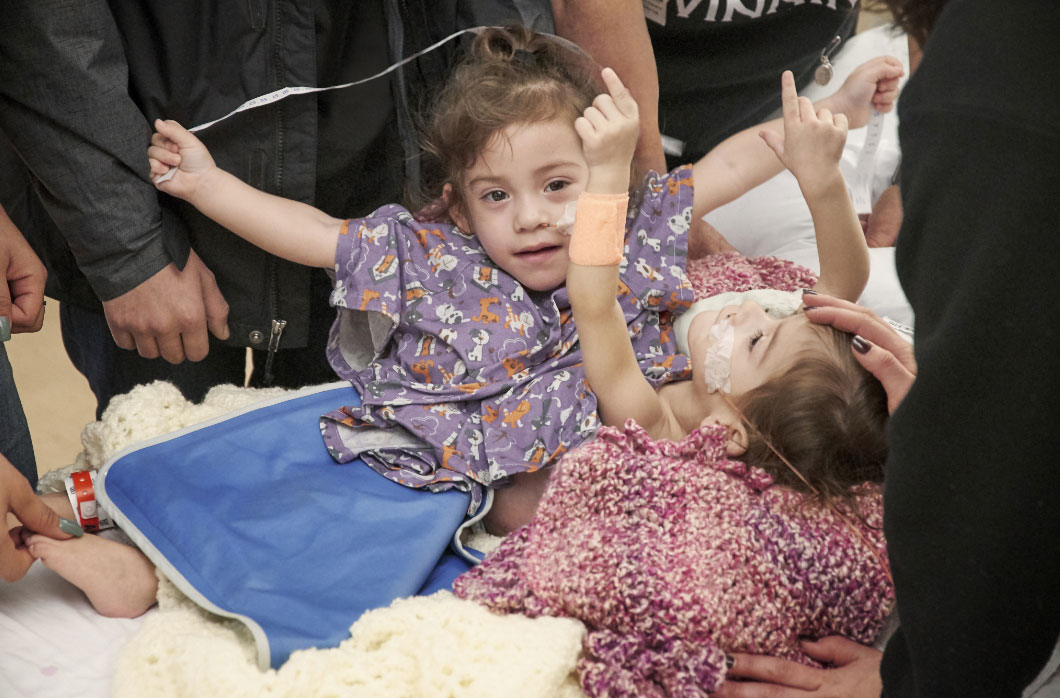
Conjoined Twin Girls Successfully Separated

Conjoined twin girls who shared much of their lower body were successfully separated after a surgery that took 17 hours, their doctors said.
The 2-year-old girls, Erika and Eva Sandoval, were born joined from the lower chest downwards, and shared a liver, a bladder and a leg, according to a statement from Lucile Packard Children's Hospital Stanford in Palo Alto, California, where the surgery was performed. They each had their own heart, lungs and stomach, but had some connections within their digestive system, the statement said.
The marathon surgery to separate the twins required a team of about 50 doctors, nurses and operating staff, and was finished in the early morning of Dec. 7. The girls are in stable condition, and are expected to stay about two weeks in the intensive care unit, and an additional two weeks in the hospital before going home, the statement said. [Seeing Double: 8 Fascinating Facts About Twins]
"It's amazing how strong these girls are and it's amazing what their team performed," Aida Sandoval, the twins’ mother, said in a statement. "Seeing them now in the ICU, you look at them and think, 'You're missing your other half,' but we know that this is the right path for them: to be independent, have the chance to succeed and explore on their own everything the world has to offer."
The surgery required extensive preparation, including CT and MRI scans, which were used to create 3D models of the girls' pelvic bones and blood vessels. Even with this preparation, the doctors still encountered surprises during surgery, said Dr. Gary Hartman, who led the surgery. For example, they found that the large intestine, which appeared to belong to Eva, had some blood supply from Erika, and this required additional testing to clarify, Hartman said.
Now that the girls are separated, they are each missing about a third of their abdomen, and they each have one kidney and one leg, the statement said. The surgeons needed to remove the third leg, and the skin and muscles in this leg were used to help close Erika's abdominal wall. The third leg had abnormal anatomy, and so neither girl would have been able to walk with it, the statement said.
Going forward, the team will assess whether the girls need any further reconstructive surgeries. "We set them up so that if everything heals well, they may not need any further surgery," Hartman said. "The results are as good as we could have asked for."
Sign up for the Live Science daily newsletter now
Get the world’s most fascinating discoveries delivered straight to your inbox.
Conjoined twins are rare and occur in about one out of every 200,000 live births, according to the University of Maryland Medical Center. Among conjoined twins that are born alive, about half do not survive for more than 24 hours.
Surgeries to separate conjoined twins are performed about five times a year in the United States, according to Packard Children's. In October, surgeons in New York successfully separated twin boys who were joined at the head.
This is the third set of conjoined twins separated at Packard Children's, with the other surgeries performed in 2007 and 2011.
Original article on Live Science.

Rachael is a Live Science contributor, and was a former channel editor and senior writer for Live Science between 2010 and 2022. She has a master's degree in journalism from New York University's Science, Health and Environmental Reporting Program. She also holds a B.S. in molecular biology and an M.S. in biology from the University of California, San Diego. Her work has appeared in Scienceline, The Washington Post and Scientific American.









